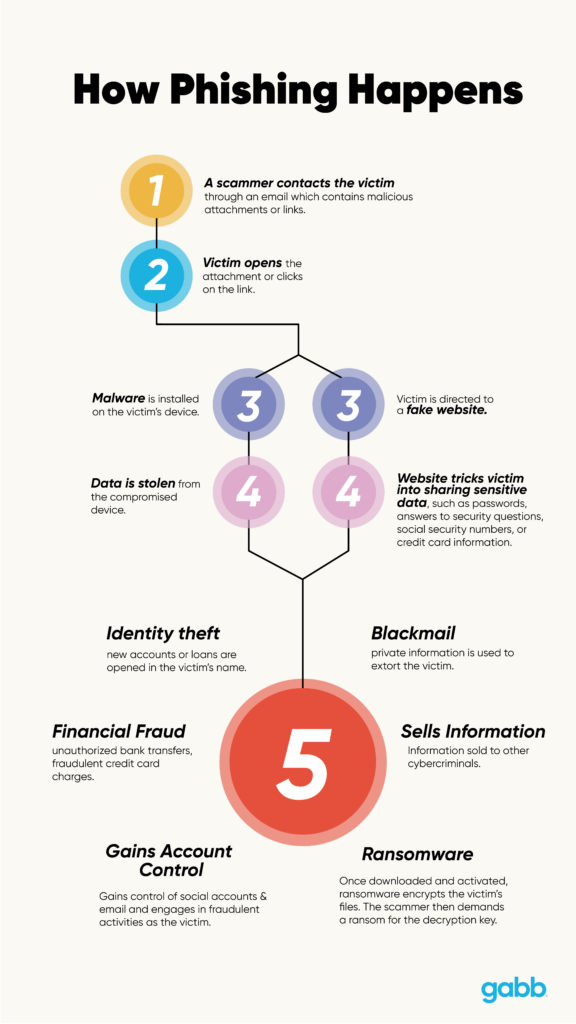I remember sitting at my high school’s computer lab and hearing a gasp from a friend next to me. He ecstatically showed me his screen and exclaimed, “I’m rich!”
The pop-up on his screen flashed congratulations and announced he had just won a million dollars. His excitement lasted only a few seconds until he saw the same pop-up on my screen.
Luckily for us, I had heard about this sort of thing on the news. I quickly explained it was a scam, and that we were unfortunately not instant millionaires.
This sort of scam is called phishing, and it’s the most prevalent type of cybercrime today. Over 500 million phishing attacks were reported in 2022, which more than doubled from the previous year.
Phishing
‘Fi-shiɳ
(noun)
The practice of tricking internet users (as through the use of deceptive email messages or websites) into revealing personal or confidential information which can then be used illicitly.
—Merriam-Webster Dictionary
Perhaps you’ve heard stories about elderly people who have been scammed and lost all their savings. But they are not the only targets who fall prey to these deceptions.
The Federal Trade Commission says 5% of all phishing scams involve people under 19 years old. Even though this figure is low, teens still need to learn the skills necessary to identify and combat phishing attacks to help them in the future.
In 2022, the FTC reported 43% of people ages 20 to 29 lost money to online fraud—almost double those of victims ages 70 to 79 (23%).
How Does Phishing Work?
The goal of a phishing attack is to deceive people into divulging sensitive information, or into taking specific actions that benefit the attacker. Phishing attacks vary, and constantly evolve to become harder to detect. Below is a simple example of how it works.

Types of Phishing Scams
Phishing scams often have a sense of urgency to them. There are many scams out there, but here are some that often affect young people and parents need to be aware of.
Gift Card Scams
Gabb employees are often targets of this kind of phishing attack. No one has fallen for it, and it’s become an office-wide inside joke. Every few weeks someone receives a phishing email or message claiming to be from our CEO, Nate Randle. In the messages, the fake Nate asks the employee to purchase gift cards, which he promises to reimburse them for as soon as he gets the gift card numbers off the back.
This is actually a common scam throughout the country. In 2022, consumers lost over $228 million in gift card scams.
Social Media Scams
Scammers create fake social media profiles that appear to be those of friends, family members, or acquaintances. They then reach out to young people, pretending to be in need or offering an exciting opportunity. Ultimately this leads the target to click on malicious links or share personal information.
Prize and Contest Lures
Phishers often entice young people with the promise of prizes or cash rewards. These unsuspecting victims are asked to provide personal information to claim their winnings, only to fall into a trap.
Impersonation
Scammers impersonate trustworthy organizations, schools, or even government agencies. They send fraudulent emails or messages, urging the recipient to take immediate action to rectify a non-existent issue.
Job and Internship Scams
Young people are especially susceptible to falling for this one as they search for job opportunities. Scammers post jobs or internship offers and request personal information, including Social Security numbers and bank account numbers, under the guise of employment requirements.
Friendship and Romance Scams
Phishers build fake relationships online, using the trust they gain to extract personal information, credit card numbers, and other financial information from their victims.

How to Prevent Phishing
A wonderful first step for kids just learning about the digital world is to provide them with a device that is specifically designed for them. All Gabb phones come with Gabb Guard, a system that blocks 95% of spam texts from ever reaching the child.
Still, even with the best tools, the way to protect them from phishing attacks fully is through education. They need to understand what phishing is, and how it operates, in order to be vigilant against it.
Encourage your children to always verify the source of the message. If they receive a message from a friend, make sure the email address, username, or phone number is correct. Oftentimes, a scammer will create a slightly modified email or profile.
Teach your children to always use strong, unique passwords to protect their online accounts. A reputable password manager can help keep track of those login credentials securely, and even suggest hard to crack passwords.
Keeping software updated can prevent potential vulnerabilities that hackers can exploit. Installing an antivirus software is also a good idea, as it can detect and prevent malicious downloads.
Promote the practice of only interacting with friends online that they have met in real life.

Phishing Solutions
Make sure to report phishing to prevent further victimization. If found in an email, look for a “Report Spam” option. This helps the email provider to improve its filters and protect other users.
The Federal Trade Commission (FTC) maintains a database of phishing emails to help with investigations. Phishing emails can be forwarded to reportphishing@ftc.gov.
Wherever the scam takes place, look for a way to report it on the platform, as it will help the organization’s IT department protect others from the same phishing attacks.
We can teach our kids to be wary of anything that seems too good to be true online. Afterall, the old saying goes, “if it seems too good to be true, it is.” With the right information and precautions, our children can navigate the online world safely and securely.
Have you experienced a phishing attack? How did you handle it? Let us know in the comments!







Success!
Your comment has been submitted for review! We will notify you when it has been approved and posted!
Thank you!